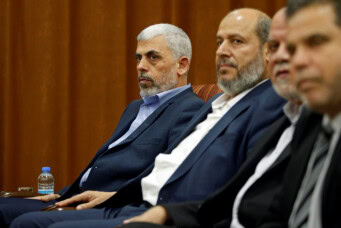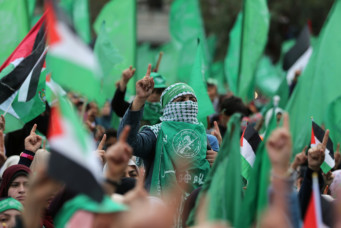Israel, Hamas, and the Burdens of History
The violence of the Hamas attacks on October 7, 2023, and Israel’s subsequent retaliatory war on Gaza have reignited historical collective traumas and existential fears among Jewish-Israelis, the Jewish Diaspora, and Palestinians

Traumas: Hamas’ Attack on Israel and Israel’s Military Response
Trauma is the Greek word for wound, but in other European languages, it denotes a profound emotional shock with latent and long-term disabling effects. Psychiatrists have traditionally applied it to individuals, but it is now increasingly used to describe group experiences. Thus, when there is an unexpected and vicious attack by an enemy or when a group becomes the target of mass violence, a “collective trauma” is the result. In From the Ashes of History: Collective Trauma and the Making of International Politics, Adam Lerner argues that scholars of international relations have radically underestimated the long-term impact of mass violence and structural injustices, whose legacies become “embedded over time, liable not only to shape dominant modes of thinking but also to resurge in importance during pivotal moments and motivate action”.
Various such events have punctuated the modern history of the Jewish people, creating collective traumas, while a century of hostile relations between Palestinian Arabs and Israeli Jews has fostered collective traumas on both sides. This essay sets the horrific and ongoing destruction of Gaza in this context in order to understand why this military campaign has received broad support from Jewish citizens of Israel, at least until recently. Furthermore, it is worth asking why this support has persisted despite vehement dissent against the overall policy orientation of Israeli Prime Minister Benjamin Netanyahu’s current government.
Confronting this paradox requires delineating why there exists a wide disparity between perceptions.
On the one hand, is the perception of this conflict by the Jews of Israel, with most Jews in the Diaspora probably concurring with the Jewish Israeli perception—although it is important to acknowledge the vocal opposition of some Diaspora Jews.
On the other hand, there are non-Jewish perceptions, though one must acknowledge significant differences between this latter residual category.
In general, Western governments, societies, and media have been supportive of Israel’s right of “self-defense”, i.e., the invasion of Gaza in pursuit of Hamas’ leaders and militants. This position has implicitly tolerated the multiple mass displacements of Palestinians, the killing of tens of thousands of Palestinian civilians, and the obliteration of their homes and civil institutions. However, as the disaster in Gaza continued to unfold 15 months later, even Israel’s allies criticized its behavior and offered some aid to alleviate Palestinian suffering. Meanwhile, most Arab and Muslim governments, societies, and media, along with several Western governments and media outlets—and let us not forget the International Criminal Court—have taken the view that Israel has flouted international humanitarian law in its prosecution of this war. The Israeli onslaught has exposed the extreme vulnerability and isolation of Palestinians, prompting these bodies to respond more sensitively to their deprivation and desperation.
What is striking, however, is that on the Israeli-Jewish side, despite avowals of support and military aid from Western countries, especially the U.S., there is an underlying feeling that it is the Israelis and Jews rather than the Palestinians who are isolated and vulnerable. As Eyal Mayroz wrote in The Conversation in February 2024:
“By magnifying old, festering feelings of isolation and victimization within Jewish society, the callous or insensitive reactions to the October 7 attack ended up inflicting damage on the Palestinian cause. . . As emotions in Israel continued to run high, more and more people adopted the view that if the world hates us so much (evoking the days of the Holocaust), we will forever have to live by the sword.”
Mayroz goes on to argue that external mediation is the only way forward for Israelis and Palestinians. Still, the asymmetry of power and the Israelis’ well-known distrust of international institutions, which he acknowledges, make it extremely unlikely that they would accede to any such proposal.
For most Israelis, the current military operations in Gaza are legitimate retaliation for the attacks Hamas launched on October 7, 2023. The Hamas attacks caused the deaths of around 1,200 Israelis, about 800 of them civilians. In addition, around 250 persons of all ages were kidnapped during the Hamas coordinated assault, many of whom subsequently died or were killed in captivity. But it was not only the number of persons killed or injured that shocked the Israeli public; it was also the extreme brutality of the assault. It should be noted that some of the alleged atrocities committed by Hamas were later shown to be fabricated, and these damaged the credibility of the Israeli government that circulated them. Nonetheless, a U.N. report of March 11, based on an extensive review of the evidence, stated that Hamas’ offensive on October 7 produced “a catalogue of the most extreme and inhuman forms of killing, torture, and other horrors. . . .” including instances of victims, some whole families, murdered within their homes and communities. A music festival in southern Israel was also the scene of extensive carnage. Dov Waxman writing in The Conversation in early October 2023, explained the same disparity between Jewish and non-Jewish feelings, affirming those of Mayroz:
“Many people who aren’t Jewish are responding as if what’s been taking place is just another episode of Israeli-Palestinian violence. But it’s different for many Jews. . . Many Jews have friends and family in Israel, so it’s very personal for them. Many Jews are still grieving, shocked, and traumatized by what happened on Oct. 7. . . Jews are often looking for what people have to say about the massacres of Israeli citizens. Most want to hear an unequivocal condemnation of what Hamas did,” Waxman wrote.
Like Mayroz, Waxman comments that the trauma and existential fear induced by the Holocaust was reactivated on October 7.
Zionism as Autoemancipation: Pinsker’s Response to Jew-hatred in Europe
While the primary contemporary trauma defining Jewish identity is the Holocaust, this event—or, more accurately, the complex Nazi-directed but pan-European processes and institutions that perpetrated the murder of some six million Jews during World War II—is not, in my view, the most appropriate historical analogy to use in analyzing the events of October 7. Gaza under Hamas is not remotely like Nazi Germany, and the attacks on Jews on that tragic day are, for all their brutality and seemingly arbitrary and indiscriminate character, hardly reminiscent of the methodically organized killing centers of the “Final Solution”. The Holocaust is nevertheless undoubtedly relevant to understanding Jewish responses, as has just been suggested, and we will return to a discussion of its relevance below.
When examining modern Jewish history, a more explicit parallel can be drawn with the pogroms that occurred in Tsarist Russia in the spring of 1881—events that later catalyzed the establishment of the Zionist movement. This analogy also has significant defects, primarily due to the vast differences between the Tsarist Empire and Hamas-ruled Gaza. It is necessary to avoid decontextualizing either the Russian pogroms or the struggle between the state of Israel and Hamas. So, let us begin by acknowledging significant differences in relations between Russian Jews and Russian peasants, with their own set of reciprocal grievances, and Israelis and Palestinians. Crucially, there is a difference between the capacity of Jews to protect themselves in 1881 and 2023. Thus, the Jews of Tsarist Russia were practically defenseless against the pogroms in 1881. By contrast, the Israeli military, though caught by surprise on October 7, possessed the means to retaliate within a short time, and in doing so—comprehensively, systematically, and disproportionately—has exhibited, if ever doubt existed, Israel’s overwhelming superiority in military force over Hamas and its allies. Three specific points reinforce and expand on the observations of Mayroz and Waxman, forming the basis for the heuristic value of this analogy in terms of subjective Jewish experience.
The pogroms of 1881 followed earlier episodes of widespread assaults on Jews, similar to how the October 7 attacks followed significant exchanges of fire between Hamas and Israel. In Russia, there were periods of coexistence between the outbreak of pogroms that nurtured hopes of a long-term change in government policy and popular attitudes. Similarly, while the relationship between Hamas-ruled Gaza and the state of Israel witnessed eruptions of violence, there were interludes of relative calm that encouraged belief in the possibility of a modus vivendi, or at least the notion that Hamas’ extremism had been moderated. It must be emphasized that Israeli policy toward Hamas before 7 October was much more collaborative than present rhetoric would lead one to believe. For all the Israeli Prime Minister’s bluster about the monstrous evil of Hamas terrorists, Tal Schneider’s headline article, published just after the 7 October massacres, contradicts him: “For years, Netanyahu propped up Hamas. Now it’s blown up in our faces”.
Second, the pogroms of 1881 and subsequent years appeared to many outside observers as part of a series of categorically related events; many Jews experienced the pogroms of 1881 as categorically distinct. The 1881 pogroms were far more widespread than previous anti-Jewish riots. Though there were relatively few deaths, Jews were horrified by the tacit approval and even outright encouragement of the violence by agents of the Russian government and members of the intelligentsia. Waxman’s observation is worth repeating here: to most Jews, October 7 was not just another violent spasm in the Palestinian-Israeli conflict, comparable to the blow-ups involving Hamas that took place in 2008-09 and 2014. For most Israelis, it was a vile and gratuitous offensive against Jewish civilians, impelled by the fanatical anti-Semitic annihilationist program of the Hamas movement. As Netanyahu told Israelis in a post on the social media platform X the day after the massacres: “Hamas wants to murder us all.”
Third, since the Jewish experience of the 1881 pogroms was, it seemed, sui generis, so was the response. Among other things, it set in motion a vast tide of emigration from Tsarist Russia. Furthermore, it produced a profound and activist reassessment of the Jews’ situation, especially by Jewish intellectuals who had believed that Russia would liberalize and that the government would eventually emancipate Russian Jews. In Leon Pinsker’s landmark Zionist essay of 1882 entitled Autoemancipation!, he exhorted Jews to completely rethink the Jewish situation. Pinsker was himself an assimilated Russian Jew and had hoped that Russia would “emancipate” its Jewish citizens, granting them legal equality and permitting their full integration into modern Russian society; still, the pogroms of 1881 shattered this hope. In his essay, he contended that Jew-hatred, “Judeophobia” as he termed it, was a psychic aberration that was hereditary, universal, and irrational. Jews, he claimed, were indeed the chosen people—“chosen for universal hatred”.
Therefore, emancipation and assimilation had failed or would fail everywhere, regardless of how things might appear at the time. The Gentile populations among whom Jews lived did not truly accept them. Although conditions in Russia were worse than in other regions, liberal Jewish intellectuals’ investment in assimilation did not change the underlying reality in European societies, which viewed Jews at best as guests and, at worst, as outsiders, strangers, and “undesirables.” The only true hope for Jews was “autoemancipation” or self-liberation, i.e., Jews becoming once again agents of history, organizing themselves into a national state through which they could enter collectively into mutually respectful relations with their neighbors.
The 1881 pogroms traumatized Pinsker, and impelled him toward a revolutionary reevaluation of the Jews’ present and future condition. In the 1880s, he became the leader of the embryonic Zionist movement before Theodor Herzl’s appearance. A similar kind of reassessment among Israeli Jews took place after October 7, with many Israeli Jews, especially partisans of the peace movement, saying that they had “woken up”. They were referring to the realization of an allegedly immovable hatred of Israel that has made and will make any negotiated peace with the Palestinians impossible. They were also referring to a new realization of Israel’s lonely position on the international stage. As Israel’s incursion in Gaza enters its 15th month, international protest against the loss of Palestinian lives, homes, and institutions continues to mount. The overwhelming support for a General Assembly Resolution calling for a humanitarian ceasefire in Gaza in December 2023 is proof of this. Thus, Pinsker’s vision of a Jewish state functioning within a larger community of states has certainly come to fruition; still, his dark paranoia about Gentile feelings toward the Jews also appears validated.
Pinsker wrote:
“No matter how many nations are at variance with one another, no matter how diverse in their instincts and aims, they join hands in their hatred of the Jews; in this one matter they are all agreed. The extent and manner in which this antipathy is shown depends, of course, upon the cultural level of each people. The antipathy as such, however, exists in all places and at all times. . . .”
To Israeli Jews, the world’s attention to Palestinian suffering in Gaza, war-crime accusations against Netanyahu, Gallant, and the Israeli military, and amnesia toward the killing and hostage-taking of October 7 are simply more evidence of the correctness of Pinsker’s judgment. This judgment gains plausibility because it aligns with a well-known religious principle or “law” that asserts the eternal opposition of “Esau” (Gentiles) to “Jacob” (Jews).
The Holocaust in Relation to October 7
Although the Holocaust may not provide the most valuable historical analogy for understanding the events of October 7 and their aftermath, it was inevitable that people would invoke it when interpreting Hamas’ killing spree that day. Thus, observers have noted that October 7 was the largest one-day massacre of Jews since the Holocaust. The implied message is that Hamas, in addition to Palestinian nationalists more generally, are ideological successors to the Nazi regime since they are guilty of the same annihilationist intention. Thus, in 2015, Netanyahu attempted to implicate the Palestinians in the Nazi genocide against Jews by charging that Hajj Amin al-Husayni, the foremost leader of the Palestinian community before World War II, had convinced Adolf Hitler to exterminate Jews instead of expelling them. While German and Israeli historians immediately called Netanyahu’s statement a disgraceful distortion, he stood by his comment, stating that he wanted “. . .to show that the father of the Palestinian nation wanted to destroy the Jews, also without there being territories, occupation, settlements”. Netanyahu wants us to believe that Palestinian hatred of Israel is rooted in a primordial murderous anti-Semitism and is not a response to Israel’s past, present, and ongoing dispossession and oppression of the Palestinian people or the perpetual frustration of their political aspirations.
This essentialist claim simply discounts the historical traumas of the Palestinians and dehistoricizes the entire conflict. Nonetheless, it attains a measure of credibility among Jews, perhaps because of acceptance of the Esau-Jacob opposition mentioned above, but also in particular on account of the Holocaust, as Mayroz and Waxman suggest. Further to the same point, Amos Elon, in his The Israelis: Founders and Sons, expounds on the Holocaust’s impact:
“The holocaust remains a basic trauma of Israeli society. . . It explains the obsessive suspicions, the towering urge for self-reliance at all cost in a world which permitted the disaster to happen. It explains the fears and prejudices, passions, pains, and prides, that spin the plot of public life and will likely affect the nation for a long time to come. The lingering memory of the holocaust makes Arab threats of annihilation sound plausible. . . .
“Six million perished not because of a cataclysm of nature, as is evoked by that inadequate term ‘holocaust’; they died not because they lacked courage, but because they lacked the minimum prerequisites for putting such courage to practice. . . In the eyes of the younger, post-Zionist generation, the holocaust has thus come to confirm one of the basic tenets of classical nineteenth-century Zionism: without a country of your own you are the scum of the earth, the inevitable prey of beasts.”
Now, it would be facile to prescribe an antidote to the effects of trauma as Elon delineates them here. Elon suggests that the antidote had already been discovered by Israel’s founders in the form of a Jewish sovereignty— and a colossal defense establishment. Nonetheless, the trauma—the “open wound”—as Elon calls it, remains operative. The Holocaust, from this point of view, is not primarily a warning to the whole world against the perils of racist dehumanization; rather, it has a lesson specific to Jews to remain united and strong or face extermination. The problem with the intrusive presence in public discourse of this latter interpretation of the Holocaust, understandable though it is, is that it produces what Lerner has called a “victimhood nationalism”. Here, trauma is neither repressed nor assuaged or sublimated but instrumentalized for the purpose of consolidating the national identity of Israelis and the transnational identity of Jews, qua victims. This consolidated victim identity seems to preclude empathy toward Zionism’s victims (per Edward Said), the traumatized Palestinian people.
In conclusion, Israelis and Palestinians need an enlarged and demythologized history of Israel-Palestine, in which both groups recognize themselves as being—to borrow a phrase from Cathy Caruth’s piece, Unclaimed Experience: Trauma and the Possibility of History—“implicated in each other’s traumas”. Only such a history, which moves toward reciprocal empathy, can produce the conditions for attaining Pinsker’s founding vision’s security, self-respect, and mutually affirming relations.




